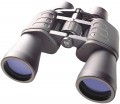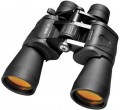Magnification
The magnification factor indicates how many times the image of any object in the eyepiece will be larger than what is visible to the naked eye. Standard values are
7x,
8x,
10x,
12x,
20x. The
higher the magnification, the greater the degree of approximation and the further the distance from which one or another object can be seen through binoculars. On the other hand, increasing the magnification usually means decreasing the angle of view, and it can be very difficult to “catch” an object of interest (especially a moving one) through binoculars. In addition, with the same lens size, a model with a higher magnification will have a smaller exit pupil size and, accordingly, a lower aperture ratio (see below for more details). For models with multiplicity adjustment (see below), this item usually indicates the maximum value of this parameter. The magnification is the first number in traditional markings like 8x40 - this example corresponds to eight-fold optics. If there is a multiplicity adjustment (see below), the markings indicate the entire range - for example, 8-12x40.
Twilight factor
A complex indicator that describes the quality of binoculars / monoculars at dusk — when the illumination is weaker than during the day, but not yet as dim as in the deep evening or at night. It is primarily about the ability to see small details through the device. The need to use this parameter is due to the fact that twilight is a special condition. In daylight, the visibility of small details through binoculars is determined primarily by the magnification of the optics, and in night light, by the diameter of the lens (see below); at dusk, both of these indicators affect the quality. This feature takes into account the twilight factor. Its specific value is calculated as the square root of the product of the multiplicity and the diameter of the lens. For example, for 8x40 binoculars, the twilight factor will be the root of 8x40=320, that is, approximately 17.8. In models with power adjustment (see above), the minimum twilight factor is usually indicated at the lowest magnification, but data is often given for the maximum. The lowest value of this parameter for normal visibility at dusk is considered to be 17. At the same time, it is worth noting that the twilight factor does not take into account the actual light transmission of the system — and it strongly depends on the quality of lenses and prisms, the use of antireflection coatings, etc. Therefore, the actual image quality at dusk for two models with the same twilight factor may differ markedly.
Relative brightness
One of the parameters describing the quality of visibility through an optical device in low light conditions. Relative brightness is denoted as the diameter of the exit pupil (see below) squared; the higher this number, the more light the binoculars/monoculars let through. At the same time, this indicator does not take into account the quality of lenses, prisms and coatings used in the design. Therefore, comparing the two models in terms of relative brightness is only possible approximately, since even if the values are equal, the actual image quality may differ markedly.
Diopter adjustment
The presence in binoculars / monoculars of the function of diopter correction. This feature will be very useful if you wear glasses due to nearsightedness or farsightedness. By setting the required number of "plus" or "minus" diopters on the adjustment scale, you can look into the eyepiece with the naked eye and see a clear picture — the optics of the device will provide the necessary correction. It is much more convenient than watching through glasses. However one should not forget that the correction range (see below) is usually small, and in case of serious visual impairments, the capabilities of the binoculars may not be enough; but such situations are still quite rare. In binoculars (see "Type"), this adjustment is usually carried out for each eyepiece separately, because The diopters required for each eye may also be different. Features of the correction control depend on the type of focus (see below). With separate focus, each eyepiece is adjusted with its own regulator, with the central one of the halves (usually the left) is regulated using a common focus handwheel, and the second with a separate knob on the eyepiece (although here there are separate regulators on both eyepieces).
Exit pupil diameter
The diameter of the exit pupil created by the optical system of a binocular/monocular. The exit pupil is called the projection of the front lens of the lens, built by the optics in the region of the eyepiece; this image can be observed in the form of a characteristic light circle, if you look into the eyepiece not close, but from a distance of 30 – 40 cm. The diameter of this circle is measured according to a special formula — dividing the diameter of the lens by the multiplicity (see above). For example, an 8x40 model would have a pupil diameter of 40/8=5mm. This indicator determines the overall aperture of the device and, accordingly, the image quality in low light: the larger the pupil diameter, the brighter the “picture” will be (of course, with the same quality of prisms and glasses, because they also affect the brightness). In addition, it is believed that the diameter of the exit pupil should be no less than that of the pupil of the human eye — and the size of the latter can vary. So, in daylight, the pupil in the eye has a size of 2-3 mm, and in the dark — 7-8 mm in adolescents and adults, and about 5 mm in the elderly. This point should be taken into account when choosing a model for specific conditions: after all, fast models are expensive, and it hardly makes sense to overpay for a large pupil if you need binoculars exclusively for daytime use.
Eye relief
The offset is the distance between the eyepiece lens and the exit pupil of an optical instrument (see "Exit Pupil Diameter"). Optimum image quality is achieved when the exit pupil is projected directly into the observer's eye; so from a practical point of view, offset is the distance from the eye to the eyepiece lens that provides the best visibility and does not darken the edges (vignetting). A large offset is especially important if the binoculars / monoculars are planned to be used simultaneously with glasses — because in such cases it is not possible to bring the eyepiece close to the eye.
Anti reflective coating
Coating is a special coating applied to the surface of the lens. This coating is intended to reduce light loss at the air-glass interface. Such losses inevitably arise due to the reflection of light, and the antireflective coating “turns” the reflected rays back, thus increasing the light transmission of the lens. In addition, this function reduces the amount of glare on objects visible through binoculars/monoculars. There are
single-layer,
full single-layer,
multi-layer,
full multi-layer. More details about them:
- Single layer. This marking indicates that one or more lens surfaces (but not all) have a single layer of anti-reflective coating applied to them. This is inexpensive and can be used even in entry-level optical instruments. On the other hand, it filters out a certain spectrum of light, which distorts the color rendition in the visible image - sometimes quite noticeably. In addition, in this case, on some lens surfaces there is no coating at all, which inevitably leads to glare in the field of view. Thus, single-layer coating is the simplest type and is used extremely rarely, mainly in budget models.
- Full single layer. A variation of the single-layer coating described above, in which an anti-reflective coating is present on all surfaces of the lenses (at each air-glass interface). Although this option is al
...so characterized by color distortion, it is devoid of another, the most key drawback of “incomplete” enlightenment - glare in the field of view. And the mentioned color distortion is most often not critical. With all this, full single-layer coating is relatively inexpensive, which is why it is very popular in entry-level and entry-mid-level models.
- Multi-layered. A type of coating in which multiple layers of reflective coating are applied to one or more lens surfaces (but not all). The advantage of such a coating over a single-layer coating is that it uniformly transmits almost the entire visible spectrum and does not create noticeable color distortions. The absence of a coating on individual surfaces reduces the cost of the device (compared to full multi-layer coating), but it is impossible to completely get rid of glare in such a system.
- Fully multi-layered. The most advanced and effective of modern types of coating: a multilayer coating is applied to all surfaces of the lenses. This way, high brightness and clarity of the “picture” is achieved, with natural color rendition and no glare. The classic disadvantage of this option is its high cost; Accordingly, full multi-layer coating is typical mainly for high-end models.Prism material
Material used for prisms found in binoculars and monoculars.
-
BK-7. A type of borosilicate optical glass (6LR61), a relatively inexpensive and at the same time quite functional material that provides, although not outstanding, quite acceptable image quality. Used in entry-level and mid-level models.
—BaK-4. Barium optical glass, noticeably superior to BK7 in brightness and image clarity, is however also more expensive. Accordingly, it is found mainly in the premium segment.
Dustproof, water resistant
The body of the binocular / monocular
is protected from dust and moisture. You should pay attention to such models if you plan to use the device in nature — while hiking, hunting, fishing, etc. The degree of such protection can vary, from splash resistance to water immersion; this point should be clarified according to the official characteristics. Also note here that most of the "waterfowl" models usually have gas filling (see above), and the absence of such filling, usually, indicates low moisture resistance.

